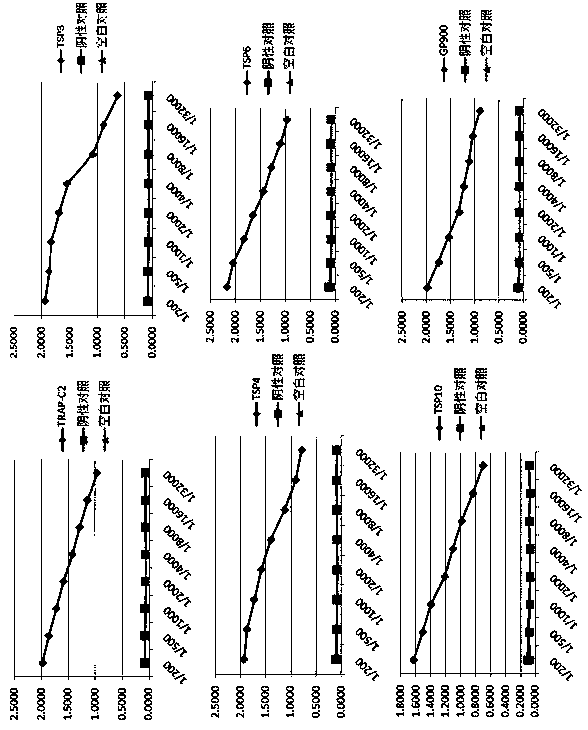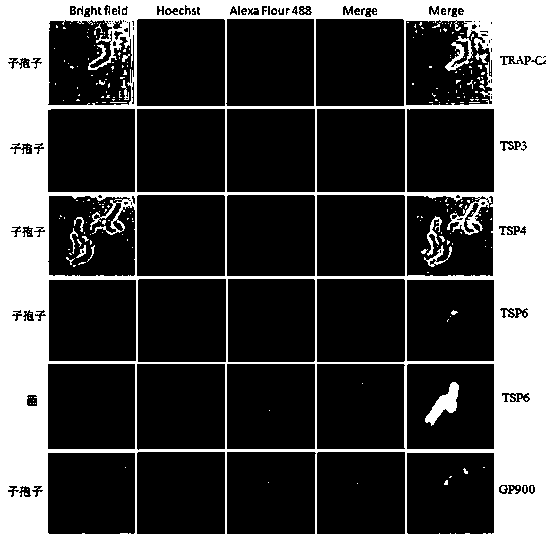TSP4 peptide sequence for cryptosporidium parvum detection and application
A Cryptosporidium parvum and peptide sequence technology, applied in peptides, measuring devices, biological testing, etc., can solve problems such as inability to distinguish oocyst viability
- Summary
- Abstract
- Description
- Claims
- Application Information
AI Technical Summary
Problems solved by technology
Method used
Image
Examples
Embodiment 1
[0036] Example 1 Screening and Synthesis of Cryptosporidium Parvum-Specific Polypeptides
[0037] 1. Screening of Cryptosporidium parvum-specific peptides
[0038] 1) Find multiple target genes on the professional website of Cryptosporidium (http: / / cryptodb.org / cryptodb / ) as alternative antigens;
[0039] 2) Use swissmodel.expasy.org to predict the three-dimensional structure of the amino acid sequence of the target gene, find the relatively strong immunogenicity of the random coil region, and then use iedb.org to predict the prediction of the B cell epitope, and finally Compare the designed peptide with other proteins of Cryptosporidium, and synthesize peptides with strong immunogenicity and specificity;
[0040] 3) In order to enhance the coupling efficiency of polypeptides with KLH and BSA, when designing polypeptides, selectively avoid polypeptides containing cysteine, and artificially add a cysteine after the polypeptide without cysteine at the C-terminus cystine. ...
Embodiment 2
[0055] Embodiment 2 Animal immunization and preparation of monoclonal antibody
[0056] 1. Experimental Animal Immunization Procedures
[0057] Mix six Cryptosporidium-specific peptides coupled with KLH with an equal volume of Freund's adjuvant, and immunize Balb / c mice; the first immunization is mixed with complete adjuvant, and the immunization amount is 100 μg, and the last 4 immunizations are mixed with no The complete adjuvant was mixed, and the immunization amount was 50 μg; the interval between two immunizations was 15 days; three days before cell fusion, 20 μg polypeptide was injected into the tail vein of immunized Balb / c mice for booster immunization.
[0058] 2. Preparation of Monoclonal Antibody
[0059] 1. Preparation of feeder layer cells
[0060] The day before the fusion cells, the culture layer cells were made; a normal BALB / c mouse was taken, killed by pulling the neck, and soaked in 75% alcohol for 5 minutes. Turn to the ultra-clean workbench, cut the abdom...
Embodiment 3
[0102] Example 3 Indirect Immunofluorescence Detection of Clinical Samples
[0103] The six monoclonal antibodies prepared in the above examples were used as primary antibodies in fluorescence detection, and the specific steps are as follows:
[0104] 1) Add a certain amount of sodium hypochlorite to the collected clinical samples for sterilization, and then use sucrose floating method to remove most of the bacteria and impurities;
[0105] 2) Add the collected concentrate to the decyst solution (containing 0.75% taurocholate sodium salt, 0.25% trypsin) and act at 37°C for 1 hour. The purpose is to incubate the oocysts of Cryptosporidium parvum The four sporozoites inside are released to detect whether the prepared monoclonal antibody can act on the sporozoites;
[0106] 3) Centrifuge at 5000g for 10 minutes to remove the decapsulation solution;
[0107] 4) Add 4% paraformaldehyde (2g formaldehyde dissolved in 50ml PBS solution) to the centrifuged mixture, let it act for 30m...
PUM
 Login to View More
Login to View More Abstract
Description
Claims
Application Information
 Login to View More
Login to View More - R&D Engineer
- R&D Manager
- IP Professional
- Industry Leading Data Capabilities
- Powerful AI technology
- Patent DNA Extraction
Browse by: Latest US Patents, China's latest patents, Technical Efficacy Thesaurus, Application Domain, Technology Topic, Popular Technical Reports.
© 2024 PatSnap. All rights reserved.Legal|Privacy policy|Modern Slavery Act Transparency Statement|Sitemap|About US| Contact US: help@patsnap.com










